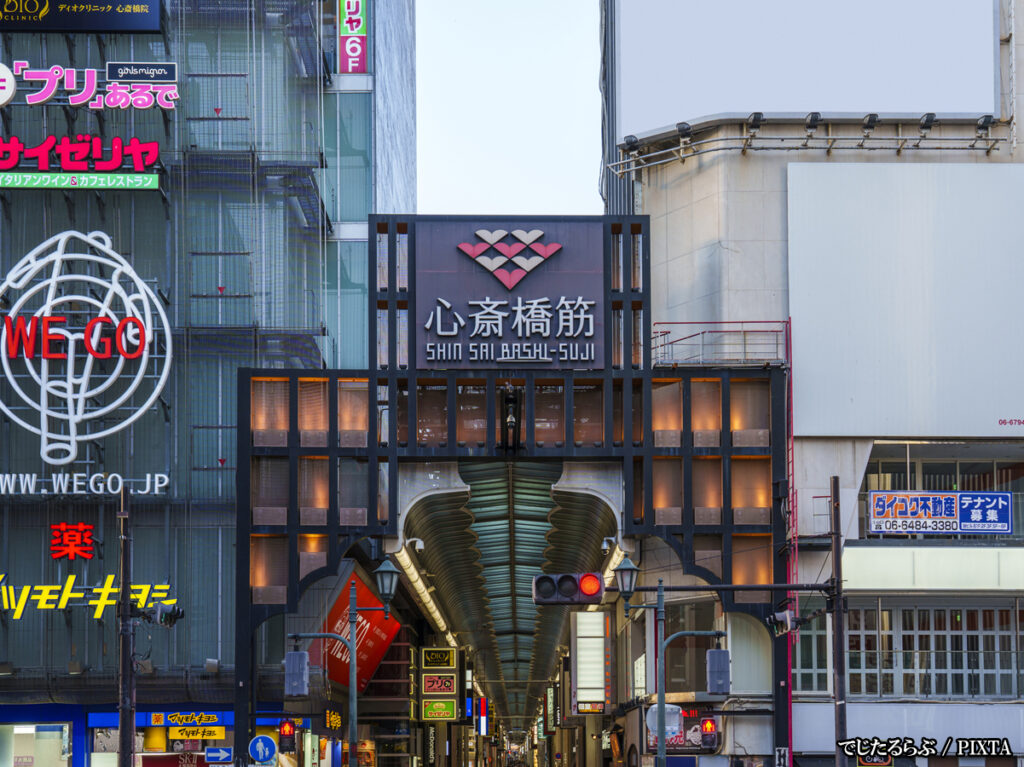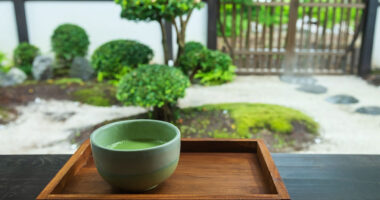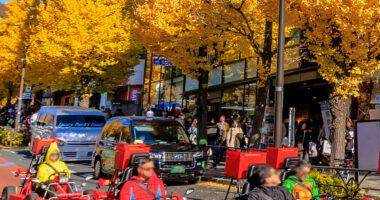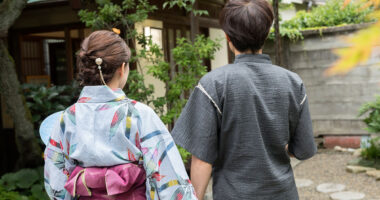Finding your way in a new city can be overwhelming—especially in a place like Osaka, where multiple train lines, complex station layouts, and language barriers can make even a short journey feel complicated. Don’t let that stop you from exploring one of the city’s most iconic destinations!
This guide is specially created for international tourists who are new to Osaka and may find navigating Japan’s train and subway systems a little intimidating. If you’re someone who wants to shop, explore, or simply take in the lively local culture of Shinsaibashi-suji Shopping Street without the stress of getting lost, we’ve got you covered.
What is the Shinsaibashi-suji Shopping Street
A place where Osaka’s history, style, and culture come together under one roof.
A must-visit spot in Osaka
Located in Osaka’s lively Minami district, Shinsaibashi-suji Shopping Street is an approximately 580-meter-long covered arcade that has become one of the city’s top shopping destinations. It’s a popular spot for both locals and tourists, offering a mix of traditional charm and modern energy.
The area dates back to the Edo period, originally developing around the historic Shinsaibashi Bridge, which once crossed the Nagahori River. Although the river and bridge are no longer there, the name and bustling spirit remain. Over time, the street has grown into a vibrant space filled with shops, cafés, and cultural flavors.
Visitors will find a wide variety of shops packed into this arcade, including well-known fashion brands, independent boutiques, souvenir stores, and traditional Japanese retailers selling items like ceramics, fans, and local textiles. You’ll also come across shops offering Japanese cosmetics, electronics accessories, shoes, bags, and everyday essentials—all conveniently located in one long stretch. Thanks to the covered design, it’s an excellent spot for uninterrupted shopping throughout the year, no matter the weather.
Surrounded by some of the city’s most popular neighborhoods and attractions, Shinsaibashi-suji offers much more than retail therapy—it’s a slice of the city’s rich history and everyday life.
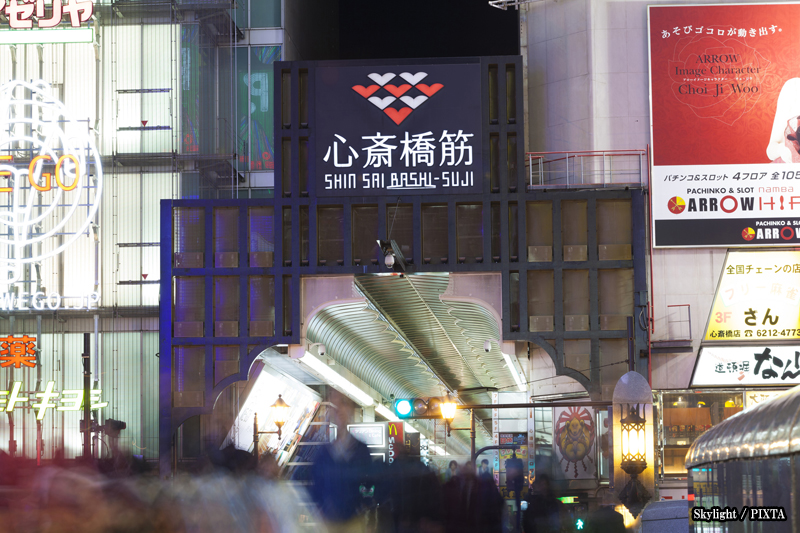
Photo for illustrative purposes
Step-by-step directions from major Osaka locations
Navigating public transportation in a large city like Osaka may feel unfamiliar at first, especially if you’re new to Japan and not used to its railway network. If you’re staying in or passing through key areas like Osaka Station, Shin-Osaka, Namba, Kansai Airport, or Tennoji, the good news is that reaching the Shinsaibashi-suji Shopping Street is more straightforward than you might expect.
This section offers clear and simple directions from each of these major spots. There’s no need to worry about complex train schedules or figuring out exact platform numbers. The goal here is to make your journey smooth and stress-free, so you can spend more time exploring and less time navigating. Whether you’re arriving by train, subway, or airport transfer, the following routes will help you get straight to the heart of Shinsaibashi.
From Osaka Station (Umeda area)
Estimated time: Approx. 15 minutes
Route summary:
If you’re coming from Osaka Station, which is located in the bustling Umeda area, getting to Shinsaibashi-suji Shopping Street is relatively quick and simple. The station is large, so it’s helpful to follow the signs for the Osaka Metro Midosuji Line. This line is conveniently connected to Umeda Station, which shares the same complex as Osaka Station, so you can easily make the transfer.
Once you’re at Umeda Station, board the Midosuji Line (Red Line) heading southbound toward Nakamozu. The ride itself will take just about three stops, and it’s a direct line, making it easy for first-time visitors. You’ll arrive at Shinsaibashi Station, one of Osaka’s most popular hubs.
At Shinsaibashi Station, follow signs to Exits 1, 4-A/4-B, 5, or 6 for the most direct access.
Tip:
Umeda Station can be a bit overwhelming due to its size and maze-like structure, but don’t be discouraged. If you’re unsure, look for the red Midosuji Line signs on the floor to guide you. If needed, feel free to ask station staff for assistance, as they’re used to helping international travelers.
From Shin-Osaka station
Estimated time: Approx. 20 minutes
Route summary:
For those arriving at Shin-Osaka Station, typically the main arrival point for travelers using the Shinkansen (bullet train), getting to Shinsaibashi-suji Shopping Street is straightforward. Once you exit the Shinkansen platform, follow the signs guiding you to the Osaka Metro Midosuji Line, which is conveniently located within the same station complex.
At the Midosuji Line platform, board the southbound train heading toward Nakamozu. The journey takes only six stops. When you reach Shinsaibashi Station, simply use Exit 2. This will lead you directly to the entrance of Shinsaibashi-suji, offering easy access to the shopping street.
Why this route works:
Since Shin-Osaka Station serves as a primary station for bullet train arrivals, it’s a perfect starting point for visitors heading to the city center. The Midosuji Line is easily accessible from Shin-Osaka, so you won’t need to make any transfers, ensuring a smooth and efficient journey straight to Shinsaibashi.
From Namba Station
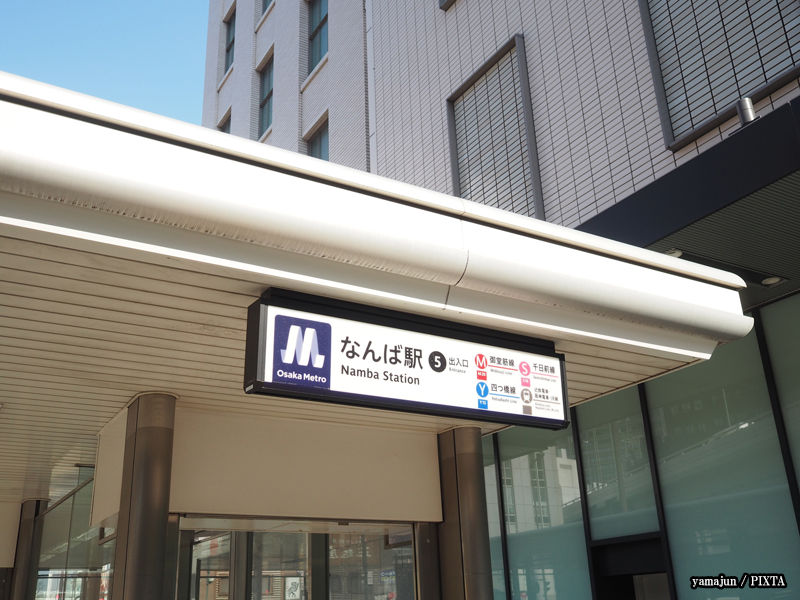
Photo for illustrative purposes
Estimated time: Approx. 10 minutes (on foot)
Route summary:
Namba Station is one of Osaka’s major transportation hubs, connecting multiple train lines such as Nankai, JR, and Osaka Metro. If you’re arriving via Osaka Metro, you’re in luck: Shinsaibashi-suji Shopping Street is just one stop away on the Midosuji Line (heading northbound). The journey takes only a few minutes, and you’ll be right at Shinsaibashi Station, which gives you direct access to the shopping arcade.
However, if you prefer to get some fresh air and take in the sights, walking is also a great option. From Namba Station, follow the signs directing you to Ebisubashi Bridge or Dotonbori, both of which are iconic landmarks in the area. Once you’re near Dotonbori, just head north along the Ebisubashi-suji Shopping Street. This stroll is not only an easy way to get to your destination but also a chance to enjoy the vibrant atmosphere of the city.
The walk takes about eight to ten minutes, depending on how many distractions (like food stalls or neon lights) you come across along the way. The streets are full of life, and it’s a great opportunity to experience the energetic pace of Osaka.
Tip:
If you want to experience what Osaka is truly known for, walking from Namba is a must—you’ll come across lively food stalls, colorful shopfronts and maybe even catch a street performance or two.
From Kansai International Airport (KIX)
Estimated time: Approx. 50-70 minutes
Route summary:
If you’re arriving at Kansai International Airport (KIX) and looking to head to Shinsaibashi-suji Shopping Street, you have two great options to consider, depending on your preference for comfort or speed.
Option 1: Nankai Railway + Osaka Metro
The most direct route involves taking the Nankai Airport Express from Kansai Airport to Namba Station. This journey takes about 45 minutes and is a convenient choice for those who prefer using the train system. Once at Namba Station, transfer to the Midosuji Line of the Osaka Metro, and board a northbound train toward Esaka. After just one stop, you’ll arrive at Shinsaibashi Station. From there, it’s a simple walk to Exit two, which leads you directly to the entrance of Shinsaibashi-suji Shopping Street. This route is quick and efficient, making it ideal if you’re traveling light.
Option 2: Airport Limousine Bus
For a more comfortable, stress-free journey, you can opt for the Airport Limousine Bus to OCAT (~48–50 min); then walk about 15–20 min to the arcade or walk about 5 min to Namba Station and take the Midosuji Line one stop. Once you arrive at OCAT, it’s just a short 10-minute walk to Shinsaibashi-suji, passing through Dotonbori along the way. This is a great option if you’re carrying heavy luggage or simply prefer a more relaxed journey into the city.
Tip:
If you have heavy luggage or prefer a less hectic travel experience, the Limousine Bus may be more comfortable, as it avoids the need for train transfers and navigating busy stations.
From Tennoji Station
Estimated time: Approx. 15 minutes
Route summary:
Tennoji Station is another convenient point in Osaka, especially for those staying in the southern part of the city or arriving from popular attractions like Tennoji Zoo or Shitennoji Temple. The station is a major hub, with easy access to both local and rapid trains.
To reach Shinsaibashi-suji Shopping Street, simply board the Midosuji Line at Tennoji Station. You’ll want to take the train heading northbound toward Esaka. The train ride is short and straightforward, taking just four stops until you arrive at Shinsaibashi Station.
Once you’ve arrived at Shinsaibashi Station, head for Exit 2. This exit places you at the heart of the shopping district, where you’ll be greeted by the entrance of the covered shopping street, lined with vibrant signs and a variety of stores.
Tip:
The Midosuji Line trains at Tennoji are frequent, so there’s usually little wait time. It’s an easy and quick way to get to the lively shopping street from Tennoji.
Walking directions from the nearest stations
Once you’ve reached Shinsaibashi Station or Namba Station, getting to the entrance of Shinsaibashi-suji Shopping Street is a breeze. Below are the steps for both stations, ensuring you have a smooth and easy walk:
From Shinsaibashi Station
- Exit 2 or Exit 5:
After getting off at Shinsaibashi Station, you have the option to take Exit two or Exit five. Both exits lead you to different parts of the shopping district, but both will bring you to the same area of Shinsaibashi-suji. - Step outside:
Once you exit the station, you’ll find yourself just a few steps from the shopping street. You’ll immediately see the covered walkway with a variety of stores, cafes, and kiosks. - Look for the arcade entrance:
It’s impossible to miss the entrance to the arcade. The covered design of Shinsaibashi-suji stretches out in front of you, with bright neon signs and store displays welcoming you into the heart of Osaka’s shopping scene. Simply follow the flow of foot traffic to enter.
From Namba Station
- Take a northerly exit on the Nankai Railway or Osaka Metro:
Depending on which line you’re using at Namba Station, take a northerly exit, for example, Exit 16 in the Osaka Metro, for either the Nankai Railway or Osaka Metro. These exits lead you directly towards the famous Ebisubashi Bridge and the bustling Dotonbori area. - Walk towards Ebisubashi Bridge:
Head east to reach the entrance to the Ebisubashi-suji shopping arcade, then turn left. Start walking toward the Ebisubashi Bridge (the bridge known for the famous Glico Sign). This area is one of the most iconic and easily recognizable spots in Osaka, so you won’t have trouble finding your way. - Continue past Ebisubashi Bridge after the Glico sign:
Ebisubashi Bridge is famous for the Glico sign which you’ll see when you turn around and look to your left. Cross the bridge and head north.. This will lead you toward Shinsaibashi-suji. Walk north along this path, and you’ll see the southern entrance to the shopping street. As you walk, you’ll start to notice the shophouses and vibrant signage guiding you right to the shopping area.
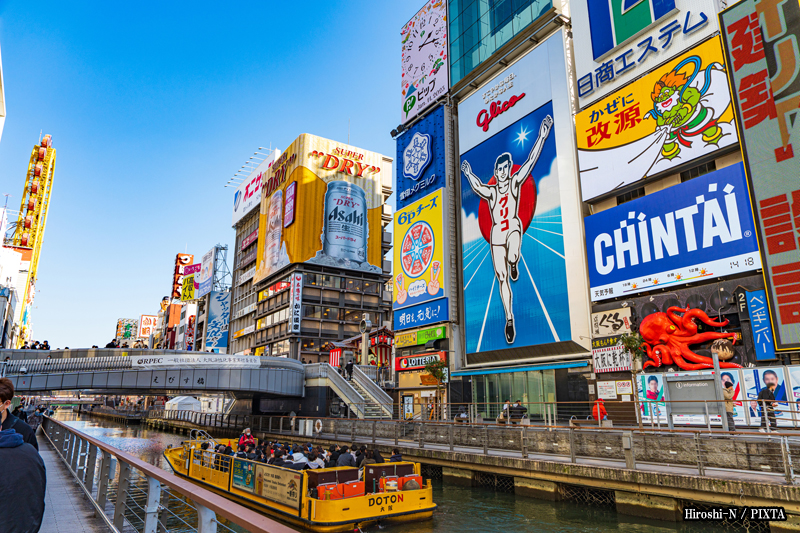
Photo for illustrative purposes
Helpful transit tools for first-time visitors
Using public transportation in Japan can be simple with the right tools. Here’s what we recommend to make your trip smoother:
IC cards (prepaid transit cards)
Using an IC card makes traveling to Osaka fast and easy. Just tap in and out at ticket gates—no need to buy a new ticket every time.
- ICOCA: Recommended for tourists staying in the Kansai area (Osaka, Kyoto, Kobe). Offered by JR West.
- Suica / PASMO: Originally from Tokyo, it is fully compatible with Osaka.
Where to get them:
- Kansai International Airport (ticket counters or vending machines)
- JR stations with “Midori no Madoguchi” service counters
- Some convenience stores also sell and reload IC cards
Helpful apps:
- Google Maps: Offers real-time train schedules, platform directions, and transfer info.
- NAVITIME Japan Travel: Special features for tourists, including station names in English and route suggestions based on passes.
- e METRO Osaka Metro App (iOS / Android): Check subway line maps, station exits, and service updates.
Pro tip:
Enable location services and download offline maps if you expect poor signal or no Wi-Fi.
Simple travel tips for a worry-free journey
Traveling in Osaka doesn’t have to be stressful. Just keep these simple points in mind:
- Buy a day pass if you’re exploring multiple spots. Options include the Osaka Amazing Pass or the Osaka Metro One-day Pass.
- Avoid rush hour (7:30-9:30 AM and 5:30-7:30 PM), especially if carrying luggage.
- Look for English signage – Most metro stations have them, and staff are generally helpful.
- Use lockers – These are found at most stations in case you want to store luggage while shopping.
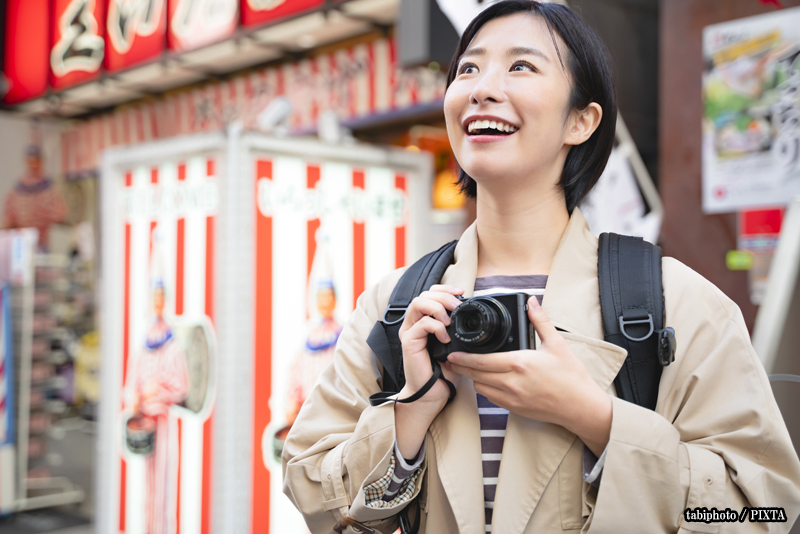
Photo for illustrative purposes
Final thoughts
Reaching Shinsaibashi-suji Shopping Street doesn’t have to be complicated. Don’t let train maps or language barriers hold you back. With this step-by-step guide, you now know the easiest routes from major Osaka spots. Add a handy IC card and a few useful apps, and you’re ready to navigate like a local!
Explore more of your dream destinations in Japan with Umami bites!
